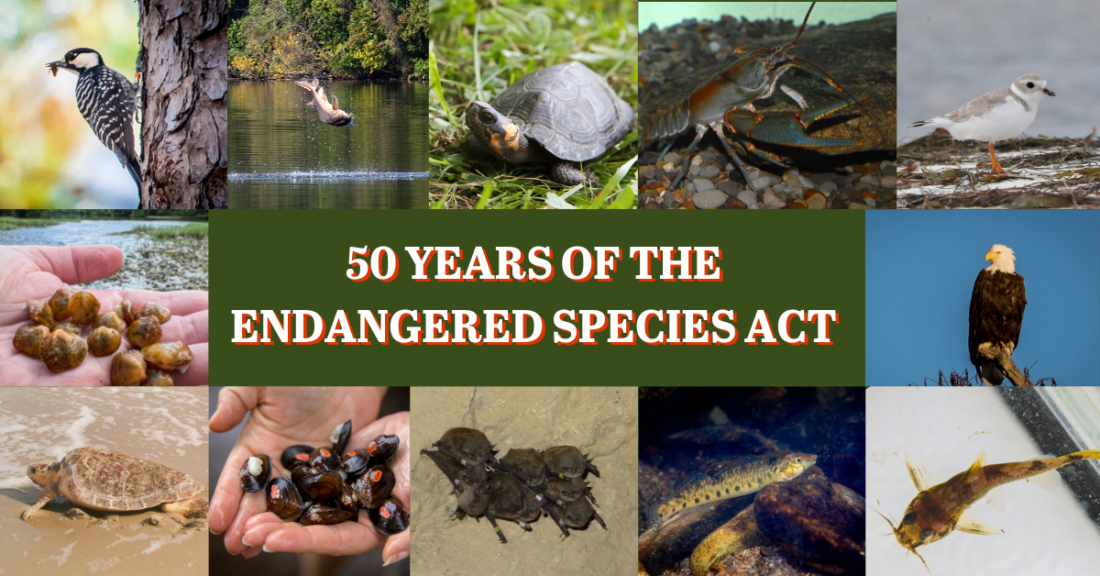
By Molly Kirk/DWR
Photos by courtesy of Meghan Marchetti/DWR, Lynda Richardson, and USFWS
When you see an iconic bald eagle soaring over the waters of the James River, hear of endangered freshwater mussel species being propagated in captivity and then released into the Clinch River, or spot a red-cockaded woodpecker flitting among pines at Big Woods Wildlife Management Area, know that the sight might not have been possible if it weren’t for the federal Endangered Species Act (ESA).
This year, the Virginia Department of Wildlife Resources (DWR) is celebrating the 50th anniversary of the ESA, which was signed into law on December 28, 1973. Each month, we’ll let you know a bit about a species in Virginia that our agency was able to impact in a positive way thanks in part to the ESA. In its 50 years, the ESA has proven to be enormously effective legislation working for the protection and recovery of species that have become so imperiled that their existence in the United States is uncertain. The ESA provides a legislative framework to:
- conserve and protect endangered and threatened species and their habitats for fish, wildlife, and plants that are listed as threatened or endangered
- provide a protocol, including scientific evaluation and public review, for adding species to and removing them from the list of threatened and endangered species
- require the preparation and implementation of plans for the recovery of threatened and endangered species
- encourage coordination among federal, state, tribal, and local officials on efforts to prevent extinction
- fund conservation work for threatened and endangered species through federal assistance and incentives
Basically, the ESA provides a blueprint to federal and state agencies and their conservation partners to hopefully turn around the downward trajectory of a species population. “The goal is always recovering it to a point where it’s no longer necessary to give it the protections of the ESA,” said DWR Deputy Director Becky Gwynn. “When a species is federally listed per the ESA, it’s a requirement to write a species recovery plan, which outlines the actions that are needed. It defines what we, the collective community that knows anything about this species, feel is the target for us to say this species no longer needs the protection of the Endangered Species Act. So, it sets goals and defines specific measures that are needed to work toward those goals.”
The most vivid example of how the ESA works is the story of the bald eagle population restoration. The species was de-listed from the Endangered Species List in 2007 after decades of work by state and federal agencies in reintroduction efforts, conservation of important wintering areas, and nest site protection.
Thanks to the ESA, DWR is able to work with other state and federal agencies to prevent and mitigate the impact of construction or development projects on endangered wildlife species. “We provide information and recommend best practices to agencies like the Virginia Department of Transportation (VDOT) and Virginia Marine Resources Commission (VMRC) about potential impacts of projects to listed species and how to avoid and minimize those impacts,” said Gwynn.
In addition, the ESA provides a funding source for DWR conservation projects aimed to benefit listed species. “It gives us the ability to prioritize and focus and collaborate with our federal partners and our nonprofit conservation partners in the effort to reverse that downward population trajectory for listed species,” Gwynn said. “That includes everything from land protection to population monitoring to active management like prescribed fire, where we’re trying to restore habitats or create a more perfect habitat for a particular species.”
Applications for funding from the endangered species program require applicants to specify what work is explicitly tied to a recovery goal or recovery action that’s identified in a species recovery plan. “We’re seeing great return on that investment, for example, at the Big Woods Wildlife Management Area (WMA), where federally endangered red-cockaded woodpeckers are taking up residence and successfully rearing young,” said Gwynn. “Our goal, ultimately, is to maintain the diversity of the commonwealth’s wildlife.”
Read recent news about red-cockaded woodpeckers in Virginia!
At DWR’s Aquatic Wildlife Conservation Center (AWCC) at Buller Fish Hatchery in Marion, DWR biologists have successful propagated and released multiple federally threatened and endangered freshwater mussel species, including the imperiled Appalachian monkeyface. Special federal endangered species permits are essential to the work of holding endangered species of mussels in captivity. “Now we’re a national leader in mussel propagation,” said Gwynn. “We don’t necessarily have the prettiest or the biggest facility, but we have the longest track record, the greatest diversity of species that we’re propagating, and, arguably, the most success with regard to what we’re doing and how many animals we’re producing and returning to the wild.”
The real challenge of all of this work to maintain and restore endangered species is the long timeline. “Any of this work that we do is that when you get to the point where an animal has to be protected under the ESA, the recovery is incredibly long, and it’s expensive,” said Gwynn. “You won’t necessarily be able to check a box and call it done in five years or even a decade. It took us multiple decades to reverse the bald eagle population to the point where it could be downlisted from endangered to threatened and then finally, to the point where it could be de-listed. Appalachian monkeyface mussels may not be recovered sufficiently to de-list the species in our lifetimes, but we at least have a path forward.”


